Calder's "Spirale" sculpture and its best friend, the Eiffel Tower
Imagining 1958 at the Palais de l'UNESCO in Paris, and I'm selling a vintage photograph of it!
❥ This email may be truncated in your inbox. To make sure you are reading the entire post, please move yourself along to a web browser!
All photographs and words here are my own, unless otherwise stated. More from me + Absolument can be found in these places:
Website | Instagram | Shop Absolument | Book Recs - Merci, thank you tons and tons for reading!
I’m feeling all sorts of rejuvenating movement these days! To go along with this energy, I revamped my website with more focus on histories and geographies. While resting on the homepage, the imagery begins to swirl and spiral in a Surrealist way. Hopefully your eyes feel pleased! The rebranding includes a really exciting new project, which I’ll get to below after our art history lesson.
A Parisian Calder
Alexander Calder’s most breathtaking Parisian sculpture shares the grey-toned sky of the country’s capital with the Frenchest woman: La Tour Eiffel.
I absolutely love seeing this picture of Calder near Spirale because it immediately makes me think of what I’ve read about his spirt and self. He’s always described first as being very American. To give a little context, he was born and raised in Pennsylvania to artist parents, then moved alongside Europeans and those from other continents as he explored, created, displayed, circus-ed, and sculpted.
In The Lives of the Surrealists, author Desmond Norris described the artist from his own experience: “When you shook hands with Alexander Calder, it did not feel like the clasp of a highly refined artist, but more like the grip of a steel worker. In conversation, it was the same—you found yourself in the presence of a gruff construction engineer rather than an articulate surrealist. Yet, barrel-chested Sandy Calder was one of the most original artists of modern times.” Prudence Peiffer, while researching for her book The Slip: The New York City Street that Changes American Art Forever, discovered an archived postcard written by painter Ellsworth Kelly. “Kelly described Calder in a postcard as ‘very jovial’ and, perhaps a comment on Calder’s boisterous, ruddy presence, ‘a farmer.’”
In the mid-1950s, modern architect Marcel Breuer and two other architects were commissioned to build the Maison de l’UNESCO campus. In turn, Breuer hired Alexander Calder to create a sculpture for its garden at the southwestern entrance on Avenue de Suffren. Calder, in this era of his career, created these immense public sculptures in their entirety. However, in order to save on transportation and customs ordeals, he thought to commission someone in France to create the heaviest, most cumbersome portion. That would leave Calder to craft and transport the steel mobile topper.
In January 1958, the artist reached out to Jean Prouvé in a letter to ask, charmingly in French, if he would help make the steel pedestal base. The sculpture would require two tons of steel that spanned thirty feet in height. Its upward-extending branches would be kinetic, of course, in Calder fashion. Jean Prouvé agreed, and installation happened not too long after.
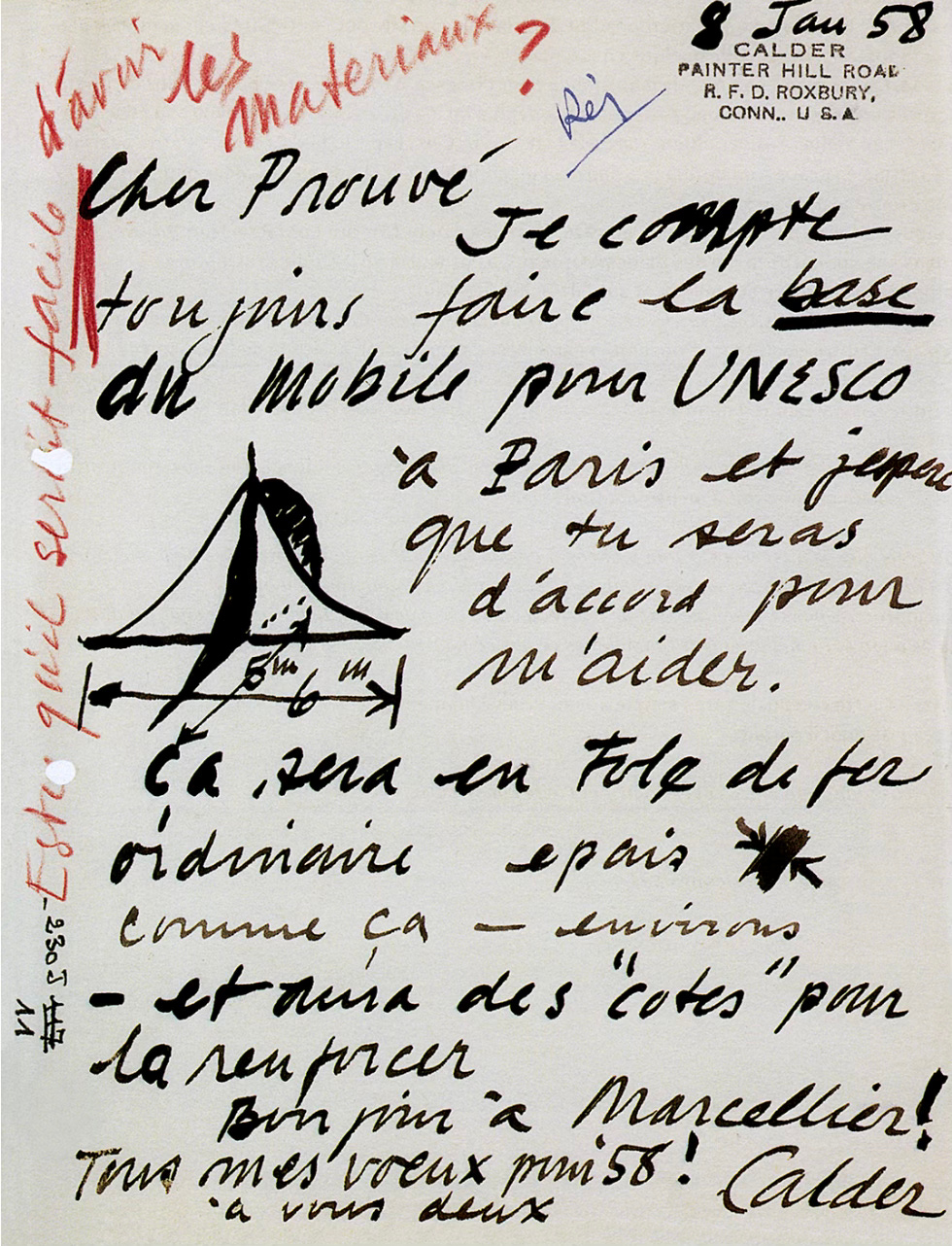
Today, if you visit the UNESCO Headquarters in Paris, Calder’s Spirale is still lively in movement, tall and sturdy in its presence, and jovial. Similar to Calder himself. ❥
SHOP! SHOP! SHOP! ABSOLUMENT !
I’ve been scheming up an online Absolument shop as I’ve been slowly collecting and sourcing vintage items from all around my adopted country of France. I have a collection of objects that I ran to with excitement, as if they had begged me to curiously uncover their histories. I’m happy to share that the shop is live!!
An inaugural piece is one that’s really special to me: a vintage photographic original of Calder’s Spirale under the snow with the Eiffel Tower.
Honestly, it’s going to be really hard to part with if/when it leaves!
I’ll update the shop over time, including more vintage ephemera, French butter curlers, and more. Think of it as my personal archive making its way to your hands and homes.
Related Calder Notes, and, the swirls are personal:
About the time when ten-year-old me signed her Social Security card with swirly letters. I still have the card (thankfully!) and absolutely love its personal flair.
When I was in my early twenties, it was my sole mission for a few years to roadtrip to Robert Smithson’s earthwork Spiral Jetty (1970) in Utah. I built up so much symbolism in the surface of Rozel Point in the Great Salt Lake. With lots of failed attempts, plus a lack of vacation time and money, I never made it. I surely need to add it to my bucket list again. For now, read The Environmental Entropy of Robert Smithson’s Spiral Jetty.
There’s an entrancing sculpture by Calder called Féminité that I want to make note of. He made it in 1930 with “wire, wood, tin, doorknobs, and paint.” What do I gleam from it? Femininity = pizzazz!
Peggy Guggenheim’s silver bed head, as created by Alexander Calder in 1945-46 is forever in my heart. Every time I see these photographs circle around the internet or in books, I just about leap out of my seat. I love it so much that I found a silver necklace just like it for my vintage ensemble at our French town hall wedding ceremony last summer. THEN, for our honeymoon, we went to Venice and saw it in person at Peggy’s palazzo!!!
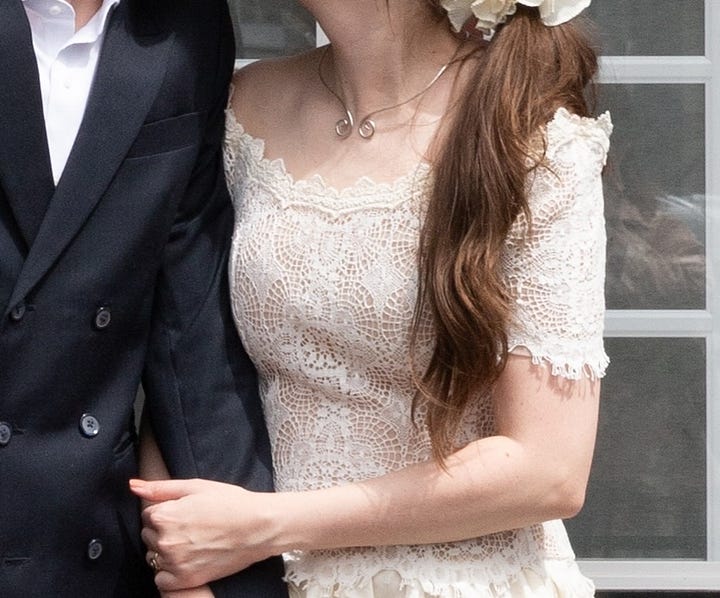
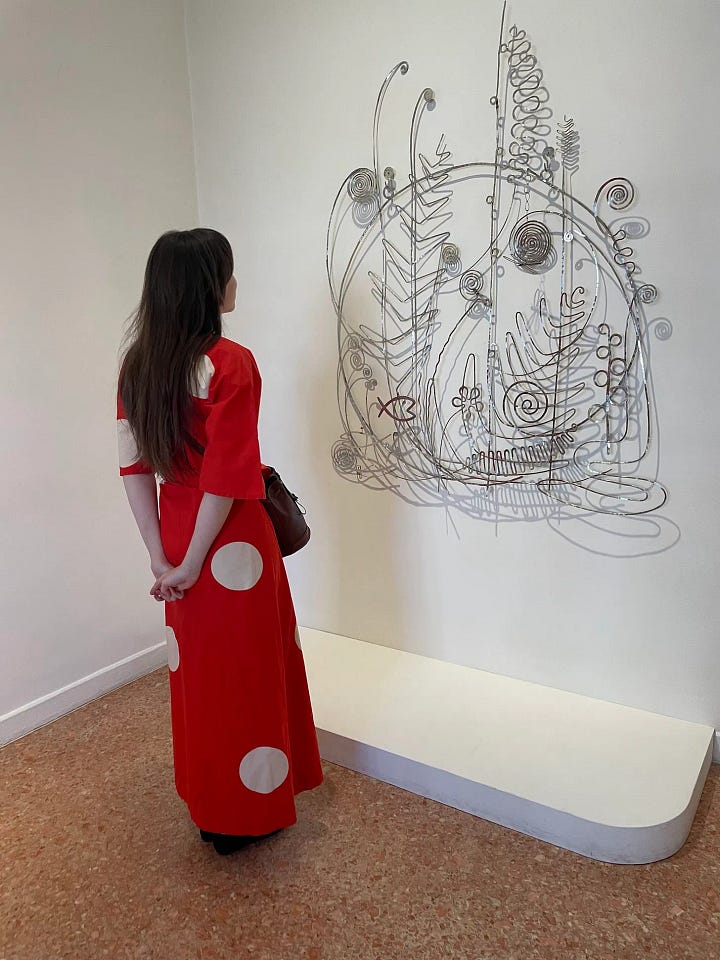
The Met’s From the Vaults series hosted a wonderful 1973 film called Art in Public Places. Our Sandy Calder is featured.
“One American master has been doing a witty balancing act for years. If his mobiles don’t reach out to tickle you, his stabiles invite you in with the grace of a genial host. Alexander Calder’s Le Guichet at Lincoln Center seems lost without venturesome visitors.”
Jaques Prévert wrote poem about Calder in 1973:
Mobile en haut stabile en bas
telle est la Tour Eiffel
Calder est comme elle
Oiseleur du fer, horloger du vent, dresseur de fauves noirs
Ingénieur hilare
Architecte inquiétant
Sculpteur du temps
Tel est Calder
Mobile above stable below / Such is the Eiffel Tower / Calder is like her / Birdcatcher of iron, watchmaker of the wind, tamer of black beasts / Hilarious engineer / Disturbing architect / Sculptor of time / Such is Calder
Speaking of poems: after Calder passed away in 1977, artist Joan Miró wrote a poem in memory of his dear friend.
Your ashes will fly to the sky
to make love to the stars.
Sandy,
Sandy,
Your ashes caress
The rainbow flowers
That tickle the blue of the sky.
I like to envision this poem as a Joan Miró painting. This one in particular is called Painting, created exactly 50 years before Calder’s passing. It even resembles one of his stabiles a bit.

**
Happy spiraling!
Kelsey Rose


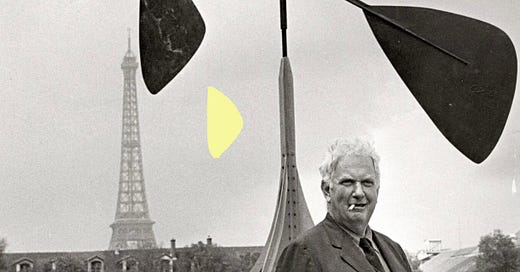






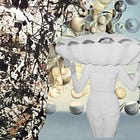
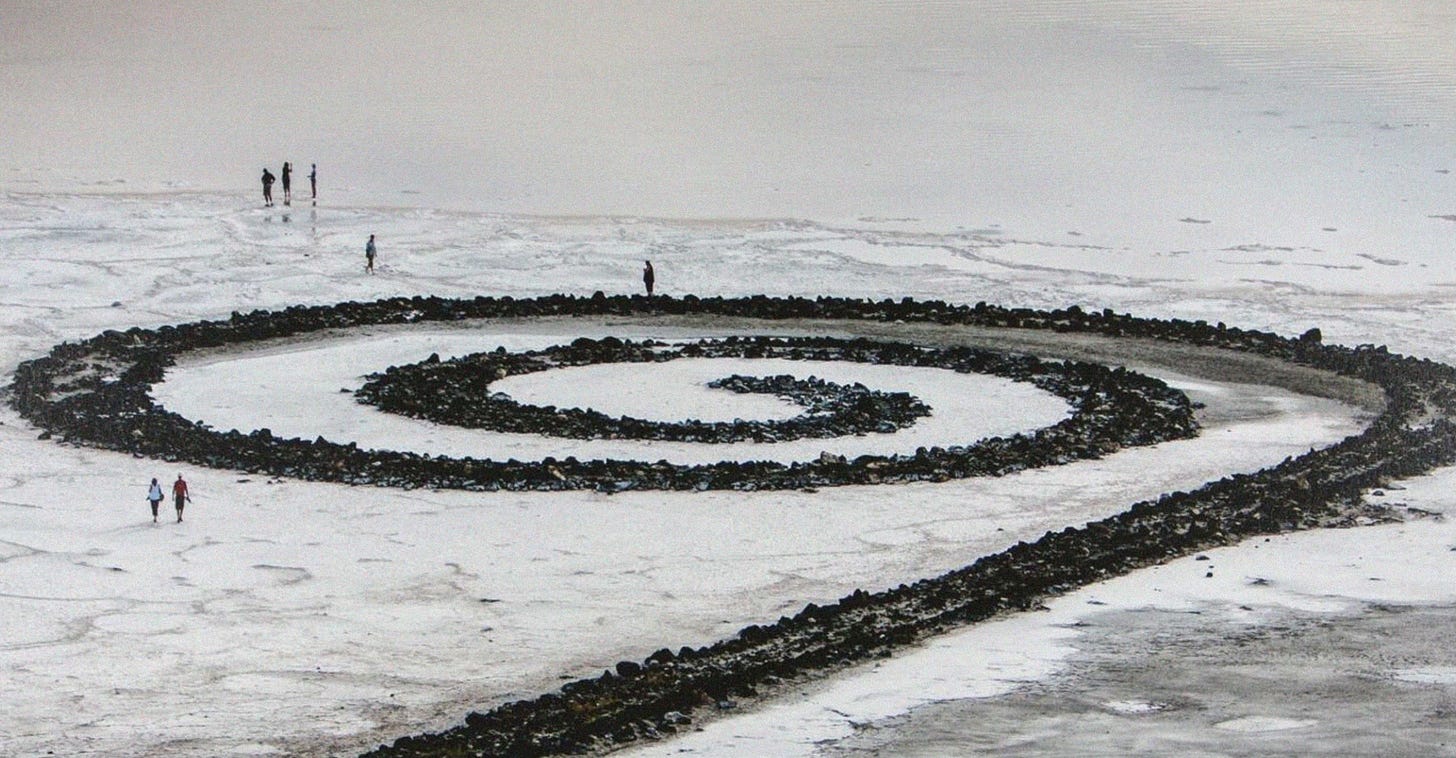
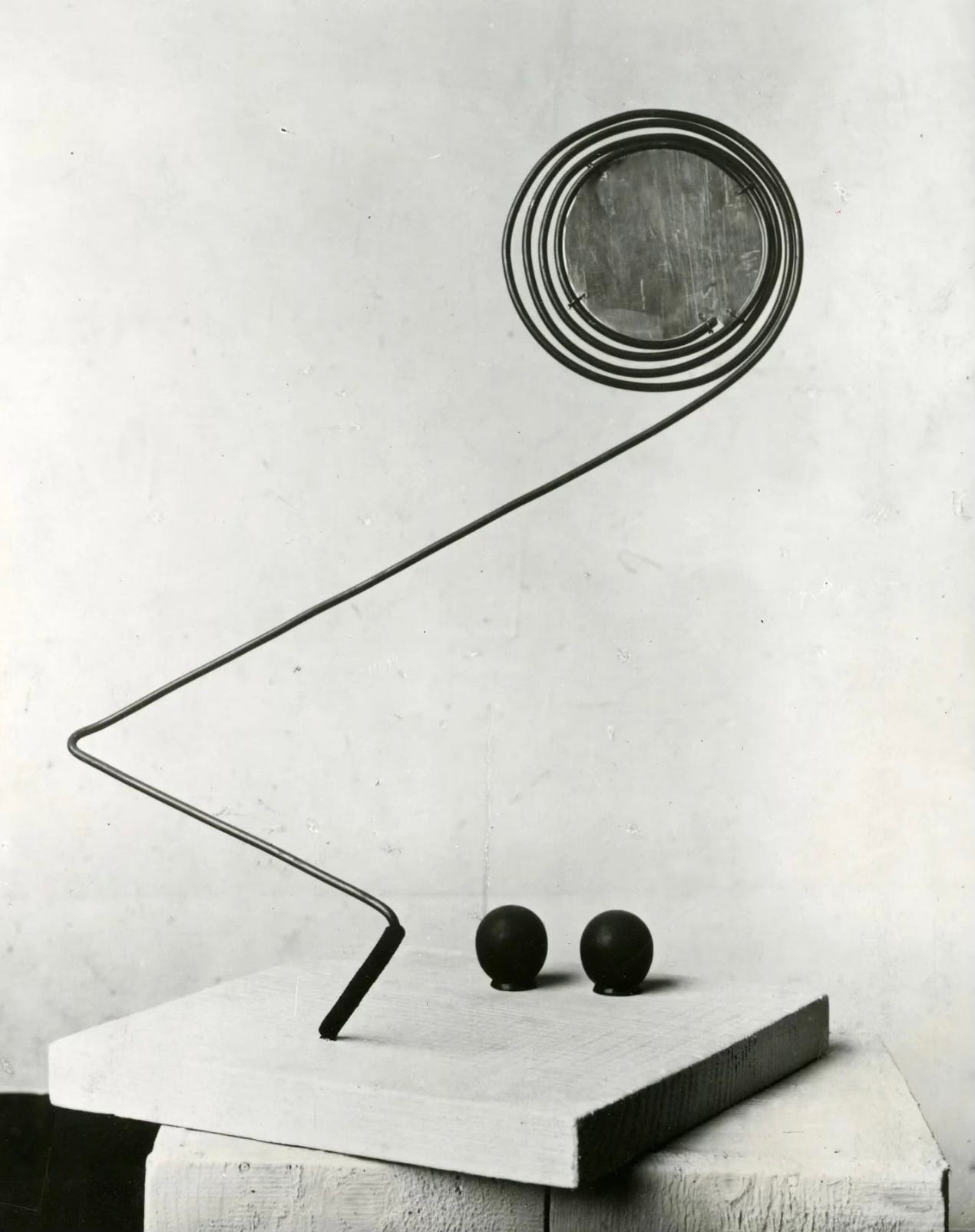
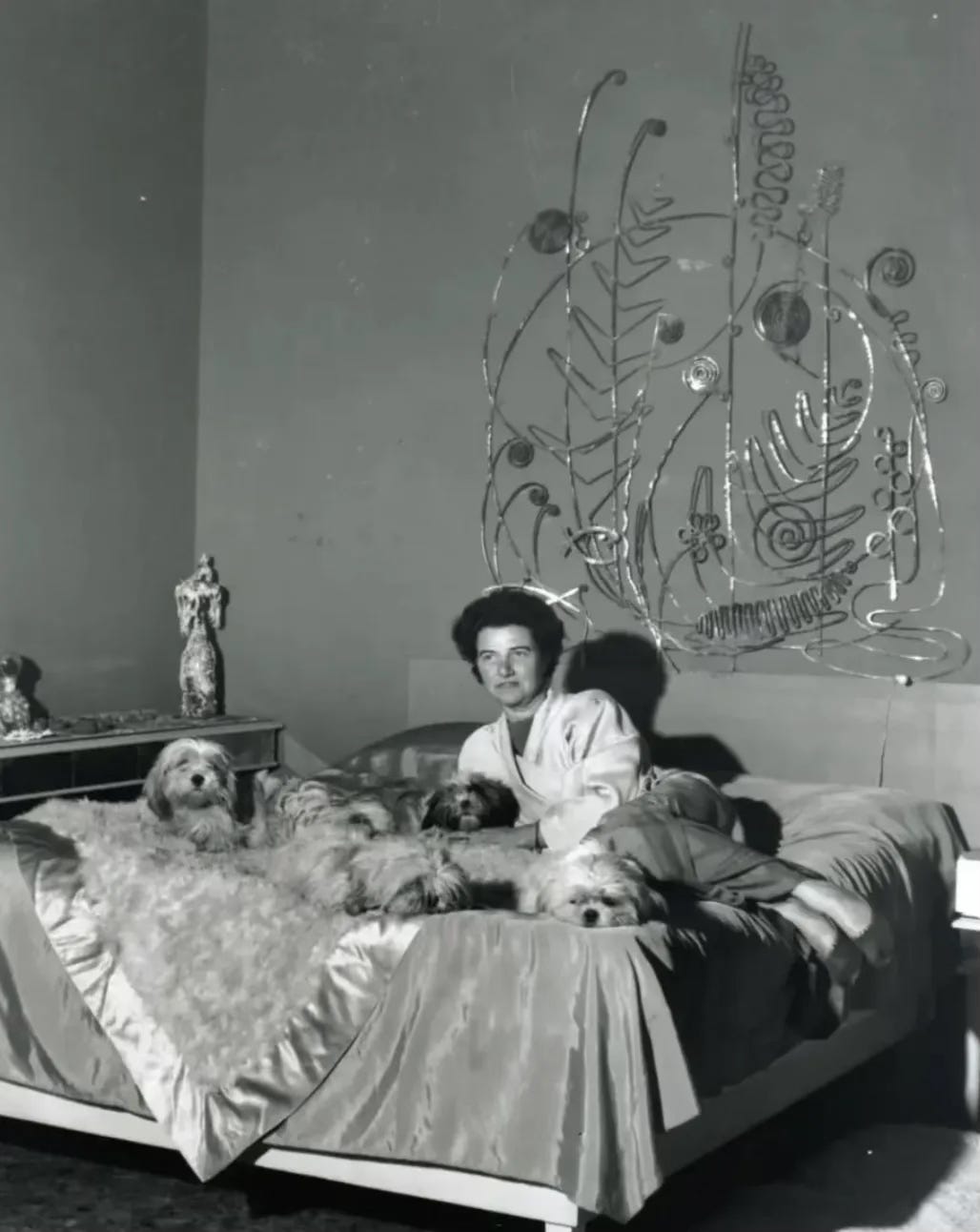

Another Calder fan here! The Calder exhibit at the Musée Soulages was one of the museum's best, and certainly my favorite. I went three times!
I loved this and these musings and am def. interested in purchasing the photo when you are ready to sell!